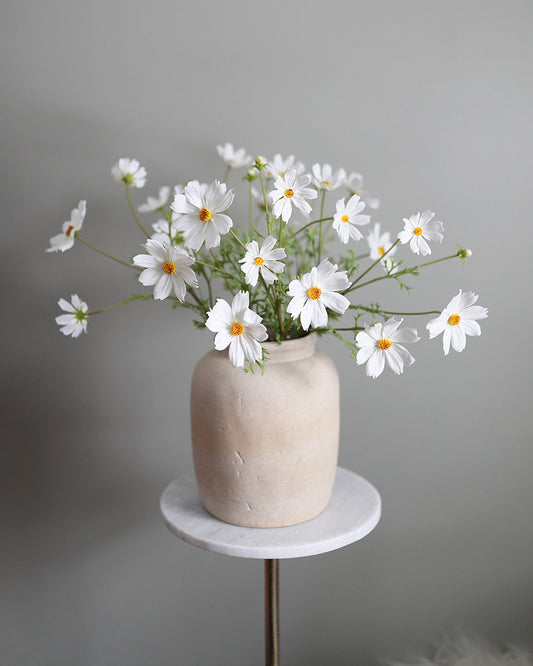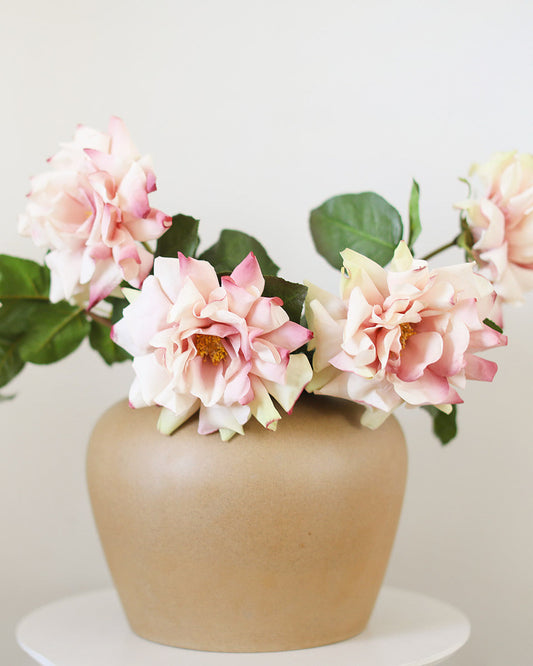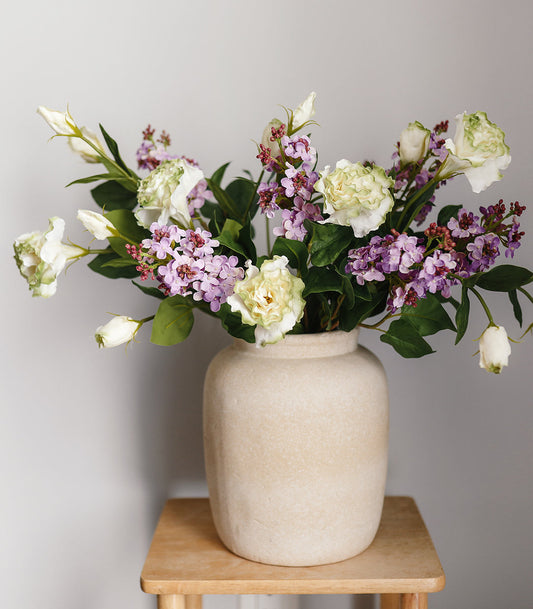Understanding Artificial Flower Definitions: Silk, Faux, Real Touch, and More

Artificial botanicals have grown immensely in popularity over the past few years, largely due to their longevity, versatility, and improved quality over time. Many terms are often used interchangeably to describe these lifelike blooms, such as silk flowers, faux flowers, artificial flowers, fake flowers, and real touch flowers (silk greenery, artificial greenery, etc). While all these terms essentially refer to the same category of products, each carries its own nuances and history. In this post, we'll break down the definitions, explain why "silk flowers" became the go-to term, and explore how modern innovations like real touch botanicals are revolutionizing the fake flower industry.
WHAT ARE ARTIFICIAL FLOWERS?
Generally speaking, artificial flowers refer to any flower that is made from man-made materials instead of being grown naturally, aka real flowers. While these blooms mimic the appearance of real flowers, they are made from materials like silk, polyester, plastic, foam, latex, and/or a blend of various textiles. While the term “artificial” might bring to mind cheap or unrealistic imitations — which to be fair they once were — today’s artificial flowers are highly detailed, realistic, and purposefully designed to rival their natural counterparts.
WHAT ARE SILK FLOWERS?
The term “silk flowers” started in the early days of artificial flower production. Let's have a little history lesson! Silk was one of the first materials used to create lifelike blooms, originating in ancient China over 1,500 years ago. Artisans once hand-dyed silk fabric and shaped it into petals and leaves to replicate real flowers. By the 18th century, these flowers became a status symbol in Europe, and were used as accents on hats, clothing, and, of course, in home decorating.
Over time, the term silk flowers became synonymous with the highest quality artificial flowers, even as the materials used to make them changed. Today, many people still widely use the term silk flowers and are under the impression that the best artificial flowers are made from a silk blend. However, modern processes rarely use actual silk these days, as other materials like polyester have proven to be more durable and cost-effective.

FAUX FLOWERS VS FAKE FLOWERS
The terms faux and fake flowers are often used interchangeably these days along with artificial flowers, but to some they do have different meanings.
Faux Flowers: The word faux is actually French and it means false. This term is often used to describe high-end artificial flowers that are designed to look as close to real as possible. The word faux has a more upscale feel to it, making it a preferred choice in the flower design world and with online retailers.
Fake Flowers: While fake flowers is technically accurate, for some reason the word fake comes with a more negative tone, and in the past it has been associated with lower-quality, or cheap, products. Think of the plastic flowers from years and years ago or even certain craft flowers or more inexpensive stores. Overall artificial flowers have come a long way, and the word fake has been used more increasingly since it feels, well, the most obvious choice when describing permanent botanicals.
REAL TOUCH FLOWERS
Among the various types of artificial flowers out there today, real touch flowers and foliage stand out as major innovations in the floral world. These botanicals not only look incredibly lifelike but also have that softer, almost cool feel like real flowers when touched. This level of realism is achieved through advanced manufacturing techniques and materials and have also come a long way in the past few years. Some materials used to create real touch florals as:
- Polyurethane (PU): A soft, flexible material that can be molded and shaped with great accuracy and actually feels like the texture and elasticity of flower petals.
- Latex Coating: Some real touch flowers use a thin layer of latex over a silk or material blend to create a natural finish with subtle imperfections. While these still have a slight feeling of real flowers, it is not as realistic as with a polyurethane stem.
- Blended Materials: As just previously mentioned, real touch flowers often combine multiple materials, such as polyester petals coated with a PU or latex finish, to find a balance between realism and durability.
Real touch flowers are naturally popular for wedding bouquets and centerpieces, upscale home decor, and really any flower arrangement where appearance and texture matter! While they are more expensive than traditional or every day artificial flowers, real touch botanicals offer unmatched realism and quality.
ARTIFICIAL GREENERY
No faux flower arrangement is complete without greenery! Like flowers, artificial greenery can come in a variety of materials and styles. The most common types of fake foliage include:
- Polyester Leaves: Durable and very versatile, polyester is the most common material often used for leaves and foliage.
- Plastic Stems: While some stems may be made of a latex blend, usually faux greenery stems are made with plastic covered wire. Plastic and wire stems provide the flexibility needed to create natural lines and shapes.
- Real Touch Greenery: High-end options like real touch eucalyptus or magnolia leaves use advanced materials like polyurethane to recreate the soft texture and natural color variations of real foliage.
Artificial greenery plays an important role in creating balanced, lifelike arrangements — not to mention they make great organic displays all on their own. Faux leaves add depth and texture to floral designs, making the overall piece look as natural as possible.

EVOLUTION OF ARTIFICIAL FLOWERS
The journey of artificial flowers from poor imitations to premium replicas is truly a testament to human creativity and innovation. The origins of artificial flowers trace back to China, where silk was delicately shaped and dyed to resemble real blooms. This artistry would eventually spread to Europe, where silk flowers became a luxury item favored by royalty and the elite.
By the mid-20th century, we saw a shift towards plastic artificial flowers, which were inexpensive and widely available, but lacked realism and were quite poor in quality.
Today, with advanced manufacturing techniques and materials and material blends — like real touch coatings, latex, and high-quality fabrics — allow artificial flowers to be a much closer match to their real counterparts. Cutting-edge designs incorporate intricate details, color variations, and lifelike textures to create breathtakingly realistic arrangements.
ARE MODERN ARTIFICIAL FLOWERS WORTH IT?
We say yes! Thanks to advancements in materials and craftsmanship, today’s artificial flowers offer numerous benefits. Modern faux botanicals are incredibly lifelike, both visually and texturally. They can last for years without wilting, making them a cost-effective option in the long-term. With no need for watering, specific sunlight, or any special care, high-quality florals can replace fresh flowers, which often require a much higher level of care and consideration.
Available in a wide variety of colors, styles, types, and sizes, fake flowers can be used for any occasion or season, from weddings to home decor to corporate events and more!
HOW TO CHOOSE THE RIGHT FLOWERS
Here are a few quick tips! When selecting artificial flowers for your home or event, keep these in mind:
- Look for Real Touch Options: If realism and texture is important to you, we always suggest opting for real touch botanicals.
- Invest in Quality: While higher-quality artificial flowers may cost more upfront, they do offer better longevity and realism.
-
Mix and Match Materials: Don't be afraid to combine different types of artificial flowers and greenery. This can result in a more organic look and be most cost effective.
- Consider the Setting: Choose styles and colors (don't forget flower quality!) that complement your space or event both in theme and location. If you are looking to create a wedding bouquet, real touch is the way to go. Looking to place some trailing greenery on a high shelf, every day options will work just fine!
For a more in depth explanation of choosing the right faux flowers and styling tips, check out our Artificial Flower Guide here.

-------------
We say this often, but artificial flowers really have come such a long way from their beginnings as hand-dyed silk petals or their rise in popularity with plastic, low-end versions . Whether you call them silk flowers, faux flowers, or real touch blooms, today’s artificial flowers offer lifelike beauty, durability, and versatility. By understanding the differences — or not such difference — between the words used to describe them and the materials used, you can confidently select the perfect artificial flowers and greenery. With modern advancements in technology, the line between real and artificial has never been blurrier — and that’s a good thing for flower enthusiasts everywhere.






